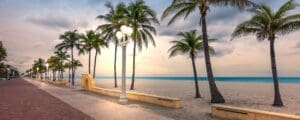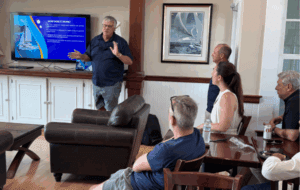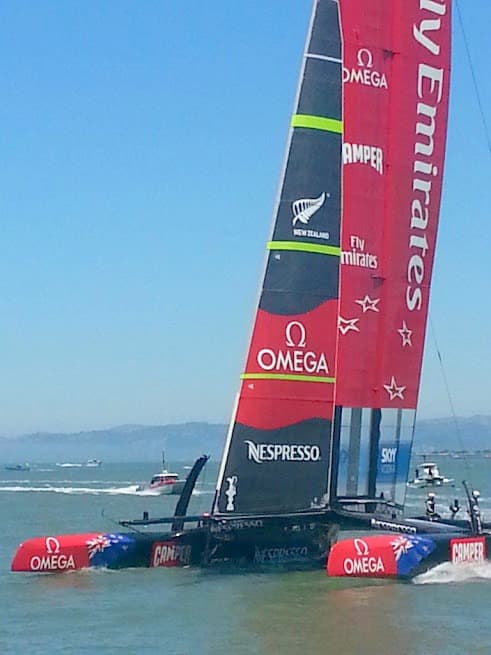 In its 137-year history, the catamaran has always garnered passionate devotees. But technological innovations in agility and speed and the foiling catamarans’ spotlight in the 2013 America’s Cup have expanded its appeal and popularity to a wider audience of sailing enthusiasts. The development of the modern catamaran from the simple ocean-going Polynesian double canoe to the most impressive multihulls on the planet has accelerated even more, with all the latest innovations in structure and composite materials. Tom Weaver, the former CEO of an America’s Cup program, comments in an article by Rob Almeida of gCaptain Maritime & Offshore News: “In the next 15 years, if you are not racing a cat, you will be racing “classic” boats.”
In its 137-year history, the catamaran has always garnered passionate devotees. But technological innovations in agility and speed and the foiling catamarans’ spotlight in the 2013 America’s Cup have expanded its appeal and popularity to a wider audience of sailing enthusiasts. The development of the modern catamaran from the simple ocean-going Polynesian double canoe to the most impressive multihulls on the planet has accelerated even more, with all the latest innovations in structure and composite materials. Tom Weaver, the former CEO of an America’s Cup program, comments in an article by Rob Almeida of gCaptain Maritime & Offshore News: “In the next 15 years, if you are not racing a cat, you will be racing “classic” boats.”
The celebrity of the catamaran is not only swelling in racing, but also for cruising catamarans. At their conception, the atypical design enabled cats to sail faster and in shallower waters with less wind and crew than other sailing vessels. But for years the unorthodox design met with skepticism, leaving the catamaran with little commercial success. Additional challenges to adoption of early versions of cruising cats were the small, very cramped interiors by modern day standards, was heavy and lumbering handling abilities. Many sailors used to say they “were built like tanks and sailed like bricks”.
However, sailors soon realized that nothing could beat the comfort, speed, and safety of a well-designed modern catamaran as a cruising yacht. These vessels can achieve the highest speed for the smoothest ride and boast the most interior space and greatest safety of most ocean-going vessels. Sailors of all types are quickly overcoming earlier prejudices against the multihull design as contemporary design trends continue to produce catamarans that are faster, more exciting, more visually interesting, and safer than ever before.
The New Trends
Fun and interesting new trends in catamarans make sailing even more exciting than ever before. However, innovations are only useful if they contribute to good design, construction, and safety principles and it should fit your sailing purposes. Let’s take a look at some trends in modern cats:
1. Larger Catamarans for Fewer Crew
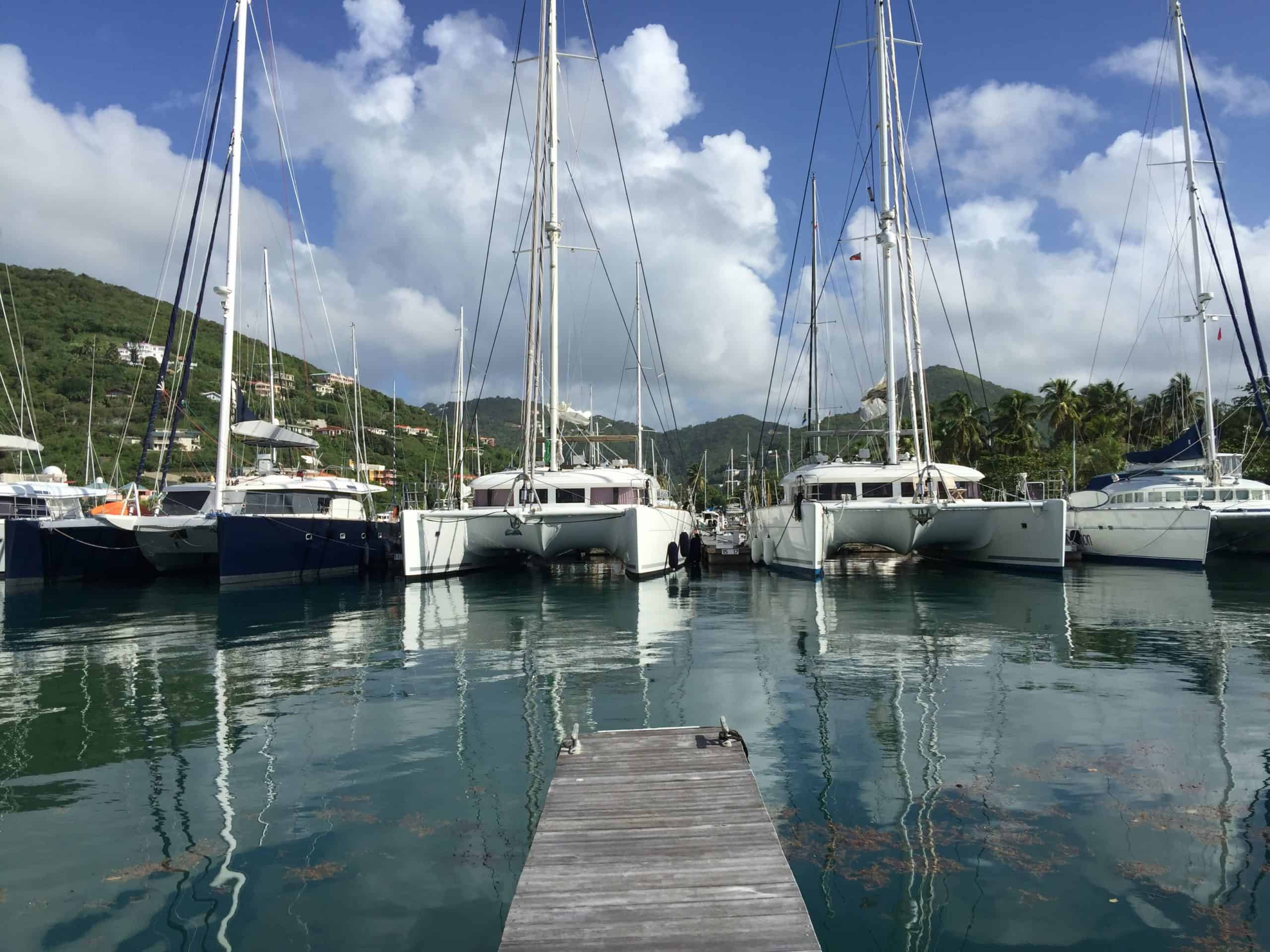 When catamarans became popular as a viable alternative to monohulls as cruising yachts, they tended to be in the 36- to 42-ft range. That was considered to be a good size range for a sailing couple to handle with ease and safety. Earlier catamarans were generally over-built and therefore much heavier than necessary. The sturdy construction was deemed to be necessary to compensate for the forces encountered with the two hulls working against each other. With the additional weight, these cats’ performance and windward ability were negatively impacted by the increased drag and displacement. Weight is the enemy of a good-performing catamaran.
When catamarans became popular as a viable alternative to monohulls as cruising yachts, they tended to be in the 36- to 42-ft range. That was considered to be a good size range for a sailing couple to handle with ease and safety. Earlier catamarans were generally over-built and therefore much heavier than necessary. The sturdy construction was deemed to be necessary to compensate for the forces encountered with the two hulls working against each other. With the additional weight, these cats’ performance and windward ability were negatively impacted by the increased drag and displacement. Weight is the enemy of a good-performing catamaran.
The new generation of catamaran, using modern composite construction and engineering can be built lighter, larger, and more spacious with very good power-to-weight characteristics. Currently, the trend leans increasingly towards larger catamarans. The average catamaran for a cruising couple now tends to be more in the 45ft to 50ft range. With composite engineering and installation of technologically advanced equipment, e.g., electric winches, furling systems, and reliable auto pilot, it is now possible for shorthanded crews to confidently sail larger boats with larger rigs. Technology has enabled modern catamarans’ bigger volume with more stiff and torsion resistant construction, without compromising stability and safety.
2. Inside Out: Convertible Main Living Areas
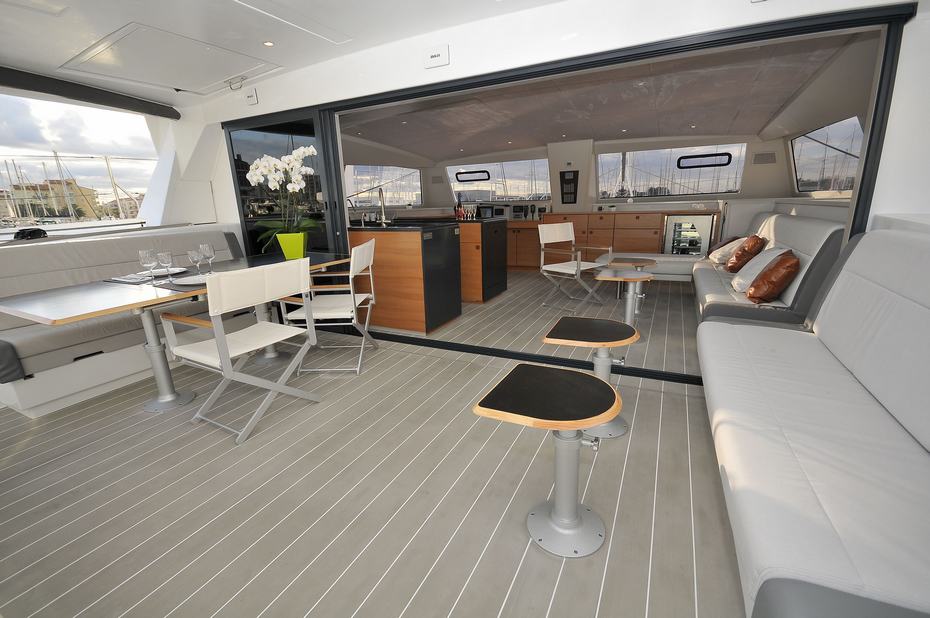 The Maine Cat was first looked upon as a bit of an oddity and rather impractical with its “open great room/cockpit” concept using only Isingass enclosures for protection. But in recent years, this pioneering design has been reinvented and perfected as manufacturers like Nautitech Catamaran, Gunboat, and Catana Catamaran embraced the concept. Traditional style salons, cockpits, and cave-like cabins are no longer acceptable options for modern sailors. Instead of separate saloon and cockpit spaces with duplicate tables and lounge areas, these spaces have merged to become one big spacious indoor/outdoor living space.
The Maine Cat was first looked upon as a bit of an oddity and rather impractical with its “open great room/cockpit” concept using only Isingass enclosures for protection. But in recent years, this pioneering design has been reinvented and perfected as manufacturers like Nautitech Catamaran, Gunboat, and Catana Catamaran embraced the concept. Traditional style salons, cockpits, and cave-like cabins are no longer acceptable options for modern sailors. Instead of separate saloon and cockpit spaces with duplicate tables and lounge areas, these spaces have merged to become one big spacious indoor/outdoor living space.
The design improvements of convertible living areas not only increases usable space and opens up the living areas, but also reduces interior maintenance and cleaning issues of traditional varnished wood surfaces. An open and convertible main living area with simple, hard-wearing composite materials reduces costs and time required to clean and maintain the boat. Big windows and opening vents allow light in and increase visibility. Gone are the submarine-like claustrophobic cabins typical of most traditional yachts. Owners’ cabins are luxurious, airy, and spacious serving as a very comfortable living space, rather than just a place to sleep.
3. Wave-Piercing or Reverse Bows
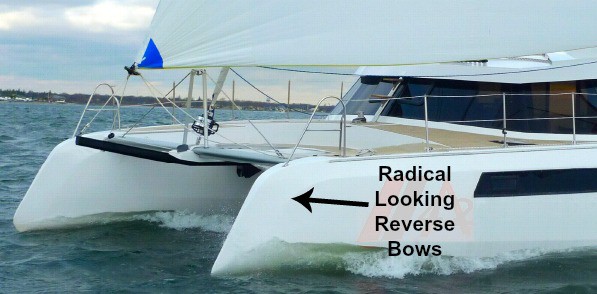
Wave-piercing or reverse bows are considered cutting-edge naval architecture and one of the latest popular catamaran
design trends. These bows are trumpeted as state-of-the-art in cruising cat design, but some have their doubts. Bows are reversed and are designed to “cut” through waves, increasing performance and motion comfort by reducing pitching or hobby horsing. According to Gregor Tarjan, designer of the Alpha 42, “the faster and longer the catamaran, the more sense reverse bows make…however, the downside is that it makes for a wetter ride.” This radical bow design certainly has visual appeal. Variations of reverse bows are in many new performance cruising designs by reputable performance cat builders like Catana, Alpha and Gunboat but the design is not quite as popular for regular cruising catamarans. The picture on the right is a demonstration of how a reverse / axebow behaves at different speeds.
4. Bulkhead Helm Stations or Twin Stern Steering?
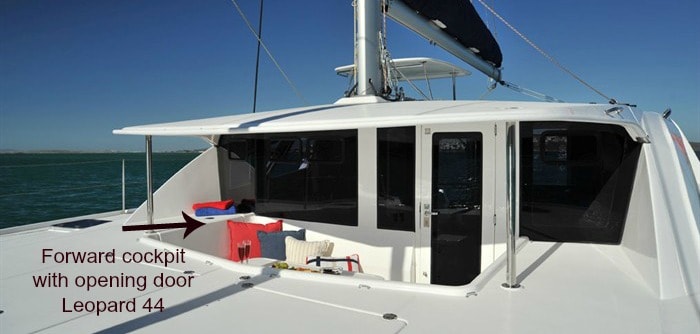 Traditionally, the most popular helm position was bulkhead steering. While that is still the most sensible and popular trend, the French twin stern steering positions offer greater visibility of the sails and give one a better feeling for sailing conditions. The benefits of the twin stern position are most appealing for day sailing or racing and not very popular for extended cruising because of the lack of protection. Owners of Catana and Nautitech who have done extended cruising, swear by the twin stern helm position, but based on consumer feedback, manufacturers like Outremer Catamaran have reverted back to bulkhead steering.
Traditionally, the most popular helm position was bulkhead steering. While that is still the most sensible and popular trend, the French twin stern steering positions offer greater visibility of the sails and give one a better feeling for sailing conditions. The benefits of the twin stern position are most appealing for day sailing or racing and not very popular for extended cruising because of the lack of protection. Owners of Catana and Nautitech who have done extended cruising, swear by the twin stern helm position, but based on consumer feedback, manufacturers like Outremer Catamaran have reverted back to bulkhead steering.
 Gunboat went a step further by designing a forward cockpit with doors opening at the base of the mast from which to control the sails, a safe work area. This cockpit is by no means protected, but because the Gunboat is a performance boat, the cockpit does not take on as much water over the bow as a regular cruising catamaran like a Leopard Catamaran. The Gunboat has substantial buoyancy forward with the bows proportionally much longer than conventional cruising cats and is therefore less prone to dive into the waves rather than over the waves.
Gunboat went a step further by designing a forward cockpit with doors opening at the base of the mast from which to control the sails, a safe work area. This cockpit is by no means protected, but because the Gunboat is a performance boat, the cockpit does not take on as much water over the bow as a regular cruising catamaran like a Leopard Catamaran. The Gunboat has substantial buoyancy forward with the bows proportionally much longer than conventional cruising cats and is therefore less prone to dive into the waves rather than over the waves.
However, Gunboat moved the cockpit back under cover in its latest designs, just as Leopard introduced a forward cockpit with opening doors into the leisure-focused salon in their Leopard 44 and 48 models. The team at Catamaran Guru questions the suitability of this design feature for blue water catamarans that will encounter large seas, but nonetheless, it is a popular trend especially for the yacht charter market.
Ultimately for a cruising catamaran, our preference is a safe, protected helm station with good visibility and all the control lines leading back to the helm to create a static control station. Push-button controlled winches and windlass as well as the instruments and autopilot should be prominently located and protected within the cockpit.
5. The Flybridge Trend
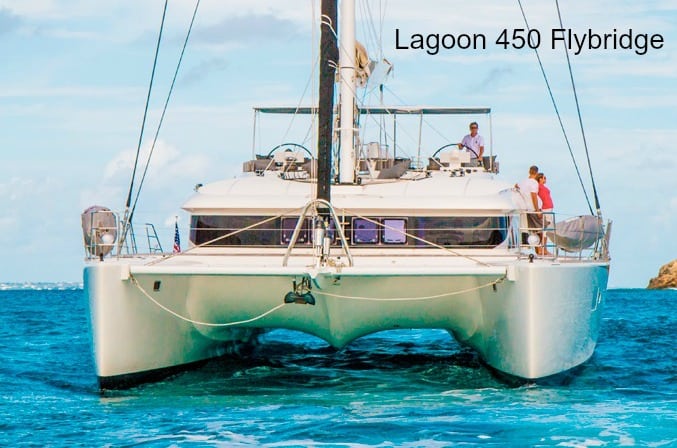 The flybridge was enthusiastically received when Lagoon first featured it in the Lagoon 440. Lagoon and Leopard continue to elevate this great concept to “new heights”. The design offers great visibility, more entertainment space and comfort and access for everyone on board to enjoy the sailing area. As with any design, this concept has its pitfalls, especially on boats smaller than 50ft. Protection from the elements is a real issue on a blue water cruising boat as most of these designs offer very little protection, if at all. Some flybridge owners have added enclosures for protection, but the flybridge and therefore the helm, are cut off from the rest of the boat making it difficult to communicate with crew.
The flybridge was enthusiastically received when Lagoon first featured it in the Lagoon 440. Lagoon and Leopard continue to elevate this great concept to “new heights”. The design offers great visibility, more entertainment space and comfort and access for everyone on board to enjoy the sailing area. As with any design, this concept has its pitfalls, especially on boats smaller than 50ft. Protection from the elements is a real issue on a blue water cruising boat as most of these designs offer very little protection, if at all. Some flybridge owners have added enclosures for protection, but the flybridge and therefore the helm, are cut off from the rest of the boat making it difficult to communicate with crew.
Getting from the cockpit up to the flybridge and back down in bad weather can prove unsafe. To accommodate the flybridge, the goose neck and boom must be very high making stowing the main problematic. The higher gooseneck position also means that the center of effort is higher which impacts the vessel’s righting moment and is not as good as catamaran with a lower boom position and bulkhead steering. Just where the flybridge design will go is anybody’s guess but right now it has huge appeal for a lot of people.
6. Hydrofoils and Daggerboards
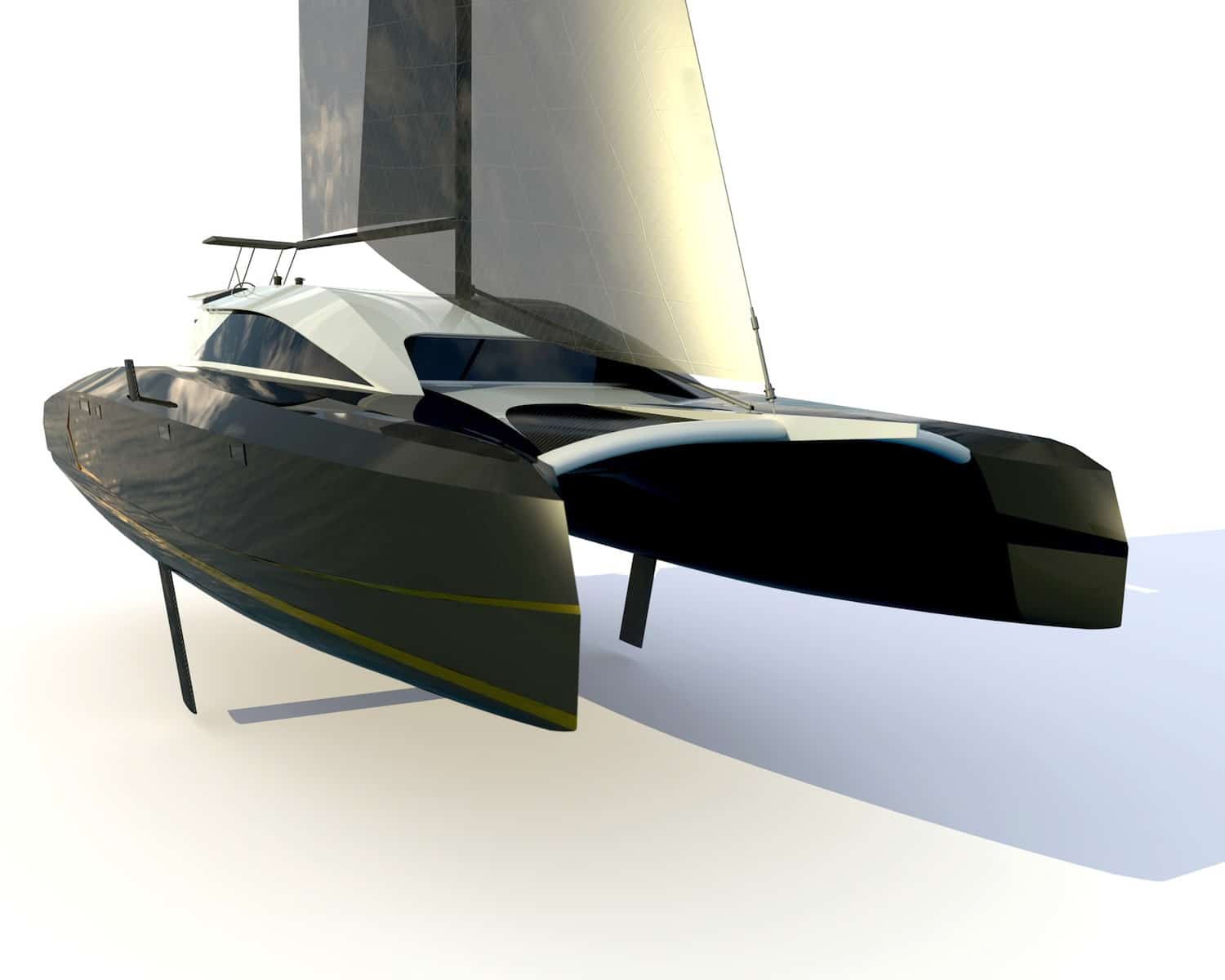 This is possibly one of the most exciting trends in catamaran design in a long while. The America’s Cup spotlight on foiled catamarans brought hydrofoils to the forefront, but this innovation has been around for a long time. “Flying on foils” is not practical on regular cruising catamarans, so yacht designers of larger boats have modified daggerboards to produce lift as well as prevent leeway, thus greatly improving performance. The Catana 59 was fitted with these curved daggerboards that look like foils. This design lifts the boat slightly when it reaches higher speeds, making it feel lighter and faster.
This is possibly one of the most exciting trends in catamaran design in a long while. The America’s Cup spotlight on foiled catamarans brought hydrofoils to the forefront, but this innovation has been around for a long time. “Flying on foils” is not practical on regular cruising catamarans, so yacht designers of larger boats have modified daggerboards to produce lift as well as prevent leeway, thus greatly improving performance. The Catana 59 was fitted with these curved daggerboards that look like foils. This design lifts the boat slightly when it reaches higher speeds, making it feel lighter and faster.
Because of design innovations like curved daggerboards and the hydrofoils, performance on cruising catamarans has improved tremendously but catamaran speed is relative. The most important benefit of speed of a multihull is the ability to outrun bad weather. Being able to average 2-3 knots faster on a catamaran than on a monohull, can help avoid bad weather. Many cruisers often tell us at Catamaran Guru, “I don’t care about performance,” but its not long before they understand that the heavy cruising cat is not quite as comfortable at sea – AND very slow. It makes no sense to buy a catamaran that will not sail at least 200nm per day when making passage.
7. Galley Up or Down
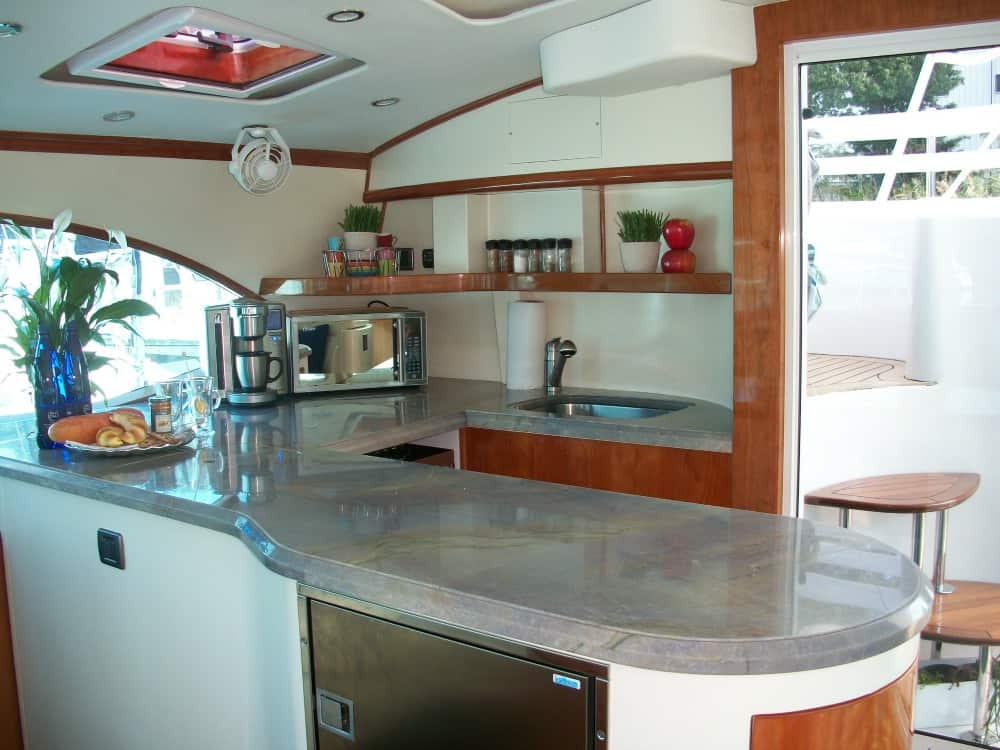 Galley up or galley down? We are asked this question more often than most other about catamaran cruising life. With sailing becoming more accessible to more people and to families, galleys have become increasingly important spaces in a yacht. The most important feature for any galley is its functionality when at sea. It should be safe, well-ventilated, and functional whether located up on the bridgedeck or down in the hull.
Galley up or galley down? We are asked this question more often than most other about catamaran cruising life. With sailing becoming more accessible to more people and to families, galleys have become increasingly important spaces in a yacht. The most important feature for any galley is its functionality when at sea. It should be safe, well-ventilated, and functional whether located up on the bridgedeck or down in the hull.
In modern catamarans, the most popular trend currently is galley up, making it a focal point of the main living and entertainment areas. When at sea, every meal comes from the galley, so live-aboards spend a lot of time in the galley and many cruising couples and families find that the separation of galley down in a hull is not ideal. When at sea, hauling hot food up and down the stairs is a safety hazard. Having the galley on the same level as the serving area and cockpit is less tiring and safer. Also, ventilation is better on the bridgedeck than down in the hulls, which makes cooking more comfortable, especially if you are prone to seasickness. The disadvantage of the galley up design is less privacy for the cook’s messes and it can significantly impact the size of the saloon seating area, especially on smaller cats.
Some manufacturers like the St Francis 50 and Antares 44 still trust in the galley down design. Galley down is often preferred for charter boats because it provides a private, self-contained cooking area with dedicated prep areas and utilizes space in the hull that might otherwise be less efficiently used. However, the most popular trend is galley up and it makes sense to most sailors, especially cruising couples and families.
More on our take for galleys up or down.
Is Speed and Interior Comfort Trumping Good Design?
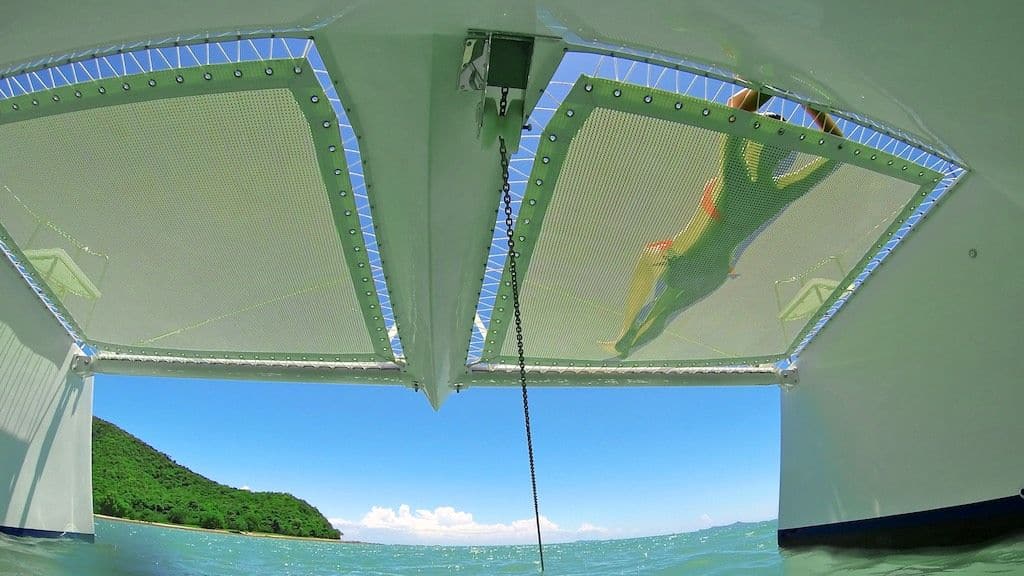 As we said before, a trend makes sense for your boat when it fits your sailing purposes but most importantly, it is the ability for sailors to stay dry, warm, and as comfortable as possible when at sea. Paramount to safety is being able to handle the boat and sails in the safest, easiest environment possible. There are many characteristics that make a good ocean-going vessel but these three are more important than most:
As we said before, a trend makes sense for your boat when it fits your sailing purposes but most importantly, it is the ability for sailors to stay dry, warm, and as comfortable as possible when at sea. Paramount to safety is being able to handle the boat and sails in the safest, easiest environment possible. There are many characteristics that make a good ocean-going vessel but these three are more important than most:
- Catamaran stability is a function of beam and buoyancy, so light-weight strong construction, which translates into buoyancy, is a good thing. Typically cruising catamarans have a beam-to-length ratio of roughly 50%, meaning a 45′ long cat will be about 22′ wide. This will not only result in great interior space but also in a very stiff and efficient boat.
- The boat needs to have a robust COG (center of gravity) through good buoyancy fore and aft or waterline length to avoid “hobby horsing”, making for a smoother ride and better performance. Performance is a safety issue; it is always better to have the pace to get out of the way of bad weather. So some speed in reserve is great.
- Good bridgedeck clearance is important for seaworthiness and crew comfort at sea, by reducing slamming and better performance in rough conditions. However, a very high bridge deck clearance, together with, say 6.5ft of headroom in the saloon, the boat will be very high with a lot of windage. So there has to be a balance struck between bridge deck clearance and the height in the salon. A good rule of thumb for bridge deck clearance is to have good clearance is about 5% of overall length of the hull but 6% is excellent. A clearance of 4% is acceptable but on the low side.
Even in the age of computer modeling, yacht design remains a series of compromises and the use of a boat will dictate its visual design and performance characteristics to a large degree. A well-designed catamaran is ergonomic and pleasing to the eye. It should be sensible and safe, with performance that can get to a safe harbor when necessary. It all comes down to safety and comfort, especially in rough conditions.
Looking to buy a yacht? Contact us if you have any questions regarding catamarans for sale, Fractional Yacht Ownership or our Charter Management Programs.



